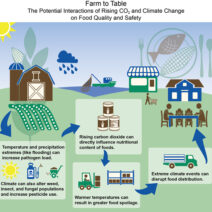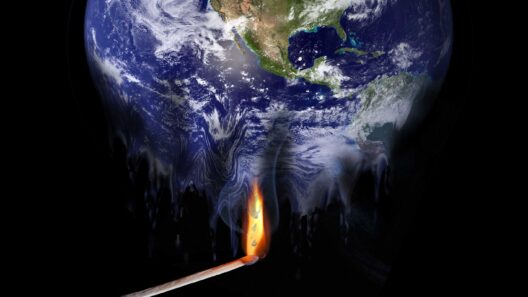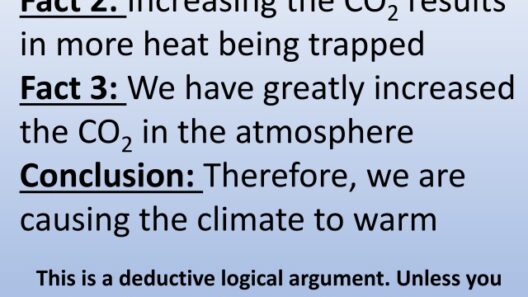As we navigate the contemporary discourse surrounding climate change, an insidious and often overlooked phenomenon emerges: ocean acidification. A direct consequence of global warming, this phenomenon serves as a silent killer, threatening marine life and ultimately impacting human health and wellbeing. To comprehend fully the ramifications of ocean acidification, one must delve into the intricate relationship between rising atmospheric carbon dioxide (CO2) levels, the oceanic absorption of this gas, and the subsequent biochemical transformations that ensue.
Carbon dioxide is an ubiquitous byproduct of numerous anthropogenic activities, including burning fossil fuels, deforestation, and industrial processes. As CO2 concentrations rise in the atmosphere, a significant portion is absorbed by the oceans, where it reacts with water to form carbonic acid. As this process unfolds, it depletes the ocean’s carbonate ions, which are crucial for the formation of marine organisms’ calcium carbonate structures, such as corals, mollusks, and various plankton species. The reduction in available carbonate leads to decreased calcification rates, which jeopardizes the very foundation of marine ecosystems.
The implications of this phenomenon extend beyond individual species; they reverberate through the entire marine food web. Coral reefs, often referred to as the “rainforests of the sea,” are particularly susceptible to acidification. Here, the juxtaposition of high biodiversity and vulnerability creates a precarious balance. As ocean acidity escalates, coral bleaching events become more frequent, undermining the structural integrity of these ecosystems. The loss of coral reefs displaces reliant species, diminishes biodiversity, and disrupts the delicate ecological interactions that have evolved over millennia.
Moreover, the ramifications of ocean acidification are felt beyond the confines of the aquatic realm. Communities that depend on fishing and marine resources for their livelihoods face dire challenges as shellfish and other calcifying organisms struggle to survive in increasingly acidic waters. The economic impacts compound the ecological crisis, as declining fish stocks and diminished biodiversity lead to food insecurity and stymie local economies reliant on sustainable fisheries.
Yet, even as we grapple with the multifaceted impacts of ocean acidification, the phenomenon also offers a unique lens through which to examine human behavior and environmental stewardship. The failure to curb carbon emissions suggests a disconnect between science and policy, as well as a reluctance to accept responsibility for the consequences of industrialization. The ramifications of our actions today emerge not only as a result of immediate environmental degradation but also as a legacy that disproportionately burdens future generations. This awareness must serve as a catalyst for change, driving collective efforts to mitigate carbon emissions and promote restorative practices.
An urgent call to action reverberates through the halls of scientific research and environmental policy. The need for enhanced monitoring of oceanic pH levels, coupled with comprehensive studies, can illuminate the nuances of acidification processes, revealing critical thresholds that should not be crossed. Enhanced public engagement and education are equally vital to foster a culture of sustainability. Greater awareness surrounding the impacts of acidification can empower individuals to advocate for policies aimed at reducing greenhouse gas emissions and protecting marine ecosystems.
Strategies to mitigate ocean acidification must also extend into innovative cross-sector collaborations. This can entail combining the expertise of marine biologists, ecologists, climate scientists, and policy-makers to develop targeted interventions, such as the establishment of marine protected areas (MPAs) that bolster resilience against acidification. By safeguarding critical habitats, we can create refuges for marine organisms, aiding their adaptation and survival as they navigate a rapidly changing oceanic landscape.
Correspondingly, investment in green technologies offers a promising avenue to ameliorate carbon emissions. Transitioning toward renewable energy sources, such as wind and solar power, lessens our reliance on fossil fuels and curtails the release of CO2 into the atmosphere. Additionally, adopting sustainable agriculture and land-use practices can enhance carbon sequestration, contributing to a reduction in greenhouse gas concentrations and therefore lessening the acidification of our oceans.
Furthermore, a holistic understanding of ocean acidification necessitates a global perspective. Ocean currents and climatic systems do not recognize geopolitical boundaries, emphasizing the importance of international cooperation. Collaborative research initiatives focused on acidification can forge alliances, pooling resources and expertise to develop comprehensive solutions. Sharing data, best practices, and innovative technologies can amplify the effectiveness of local and regional actions.
The pervasive threat of ocean acidification serves as a stark reminder of humanity’s intricate relationship with the natural world. As we face the unforgiving realities of climate change, the importance of collective action becomes ever clearer. Initiatives that promote sustainability and encourage responsible stewardship of our oceans must be enacted with urgency. We stand at a pivotal juncture; the decisions made today will resonate through future generations, determining whether we can avert the worst consequences of ocean acidification and ensure a thriving planet. You see, the tide is turning, and the time for impactful action is now.







